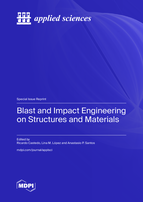Blast and Impact Engineering on Structures and Materials
A special issue of Applied Sciences (ISSN 2076-3417). This special issue belongs to the section "Civil Engineering".
Deadline for manuscript submissions: closed (20 June 2023) | Viewed by 56878
Special Issue Editors
Interests: blast and impact engineering (structures and materials); numerical modelling; computational fluid dynamics
Special Issues, Collections and Topics in MDPI journals
Interests: blast; explosives; explosions; safety engineering; mining engineering
Special Issue Information
Dear Colleagues,
Due to the high number of intentional or unintentional explosions and impact problems, it is of great importance to investigate and improve the response of structures exposed to these issues. In addition to the structures, it is important to study materials such as concrete, steel, glass, or bricks that are widely used in engineered critical constructions. Over the last decade, the investigation of these phenomena has been an area of active research in different fields including experimental studies, analytical models, or numerical simulations.
By considering the different approaches, this Special Issue invites papers that include one or more of the mentioned fields. Studies from different areas of engineering like aeronautical, civil, mechanical, or material are highly welcome.
Dr. Ricardo Castedo
Dr. Lina M. López
Dr. Anastasio P. Santos
Guest Editors
Manuscript Submission Information
Manuscripts should be submitted online at www.mdpi.com by registering and logging in to this website. Once you are registered, click here to go to the submission form. Manuscripts can be submitted until the deadline. All submissions that pass pre-check are peer-reviewed. Accepted papers will be published continuously in the journal (as soon as accepted) and will be listed together on the special issue website. Research articles, review articles as well as short communications are invited. For planned papers, a title and short abstract (about 100 words) can be sent to the Editorial Office for announcement on this website.
Submitted manuscripts should not have been published previously, nor be under consideration for publication elsewhere (except conference proceedings papers). All manuscripts are thoroughly refereed through a single-blind peer-review process. A guide for authors and other relevant information for submission of manuscripts is available on the Instructions for Authors page. Applied Sciences is an international peer-reviewed open access semimonthly journal published by MDPI.
Please visit the Instructions for Authors page before submitting a manuscript. The Article Processing Charge (APC) for publication in this open access journal is 2400 CHF (Swiss Francs). Submitted papers should be well formatted and use good English. Authors may use MDPI's English editing service prior to publication or during author revisions.
Keywords
- Explosive charge
- improvised explosive devices
- composite structures
- concrete
- field tests
- numerical modeling
- structural elements








